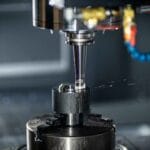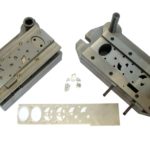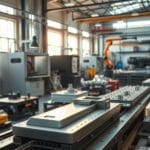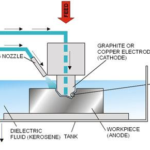It could be said that the metal stamping industry is at the very core of manufacturing today. Metal stamping refers to the process used to form metal items or components from sheet metal. These range from the simple, plain metal washers to complex components used in different industries such as medicine and aerospace, to large parts used in the construction of vehicles and even aircraft. Metal stamping is a complex subject and there are different processes and procedures involved. Let us here consider the process called progressive metal stamping and consider how progressive die design, or progressive tools can benefit the metal stamping industry.
What is Progressive Metal Stamping?
Traditionally a metal stamping press can perform only one function at a time. It has a single stroke that can result in one action. This meant that for most items requiring multiple actions a number of tools were needed and the metal had to go through the machine repeatedly or had to go through different presses sequentially. Additionally, secondary operations were often needed to ensure a proper finished product. All these meant increased labor costs, increased cost of production, increased time required for production, and also an inability to create complex, intricate components.

Progressive die design is the solution to this challenge. Progressive die stamping is the process wherein a metal strip unrolls from a coil into the die press. The die press has a number of stations and each of those stations perform a unique function. It could involve cutting, punching, bending or a host of other actions. Each station progressively adds to what has already been done eventually resulting in the finished product. There are a number of progressive tools used and these progressive tools work in sync to progressively form the item. This makes it the perfect solution to produce metal parts that have a tight tolerance or complex geometry.
Why is Progressive Die Design Cost-effective?
There are a number of reasons why using progressive tools is cost effective. Besides the limitations of traditional metal stamping processes as mentioned earlier progressive die design benefits the manufacturer in a number of ways.
1. Production of complex and intricate components
When the production of an item requires multiple actions on the sheet metal, and when complex geometries are involved, die stations with progressive tools are what can accomplish the job.
Also Read:
- Types of Milling Cutters Used in Machining Process
- Types of Lathe Machine – Mother of all Machines
- 37 Types of Hammers that You Don’t Know?
2. Turnaround time
Since sheet metal is fed into the press from coils, progressive stamping machines have the raw material continuously being fed. This enables the machine to function at very high speeds, even producing hundreds of parts per minute, and all this with minimal downtime.
3. Minimal labor costs
The machines run without much human intervention as electronic monitoring is embedded into the progressive tools. Thus, one operator can manage a number of machines at the same time.
4. Minimal setup time
Traditional metal stamping requires several tool and die changes, resulting in a huge combined setup time for the production of complex parts. On the other hand, only one tool and die setup is required in the case of progressive tools. Since various functions of metal stamping can be achieved by one operation there is a drastic reduction in the setup time required and overall processing is much faster.
5. High production volume
With sheetfed machines that run at high speed, it automatically results in higher production quantities between material changes. Thus, in a shorter period of time, a higher volume of production is achieved. With large quantities, it is very tedious to constantly change the dies and make changes to the machines. Progressive die design eliminates this hassle.
6. High repeatability
Hard tooled progressive dies can withstand the pressure of high-volume production without degradation. This ensures that quality is maintained. Progressive die designs also result in the production of robust components in a very cost-effective manner.
7. Minimizing wastage
Optimizing progressive die design results in minimal scrap being left behind after the production process. Progressive tools are designed to ensure maximum utilization of the sheet metal that is fed into the machine.
8. Low product costs
All the aspects discussed above to ensure that the production costs for even complex components are kept to a minimum with progressive metal stamping. This, in turn, translates into lower costs for the finished product.








